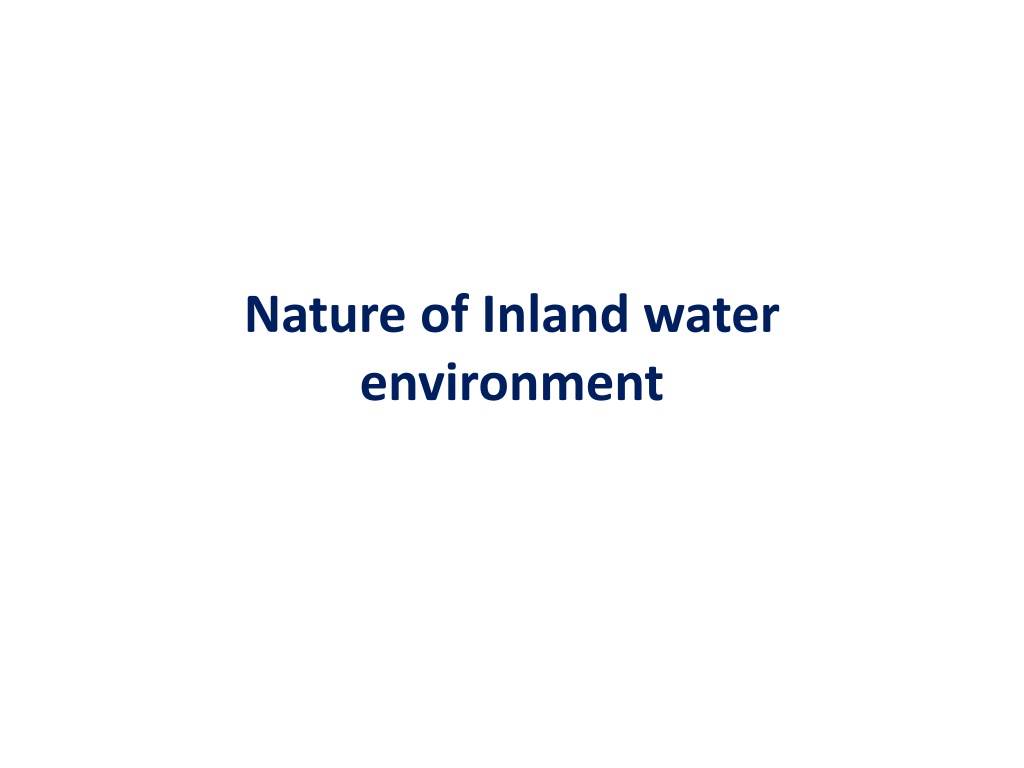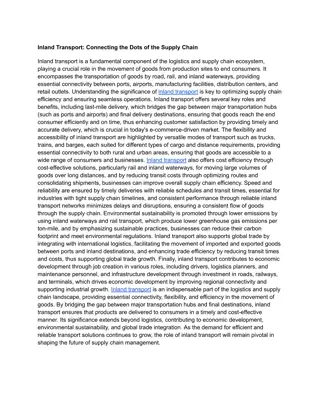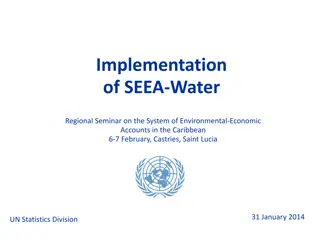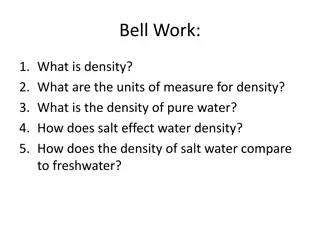Exploring Physical Characteristics and Density Relations in Inland Water Environments
Inland water environments exhibit unique physical characteristics such as pressure variations and density relations influenced by factors like temperature, pressure, and dissolved substances. Water's density changes with temperature and pressure, affecting its mobility and viscosity. Understanding these properties helps in comprehending the dynamics of inland water bodies and their ecosystems.
Download Presentation

Please find below an Image/Link to download the presentation.
The content on the website is provided AS IS for your information and personal use only. It may not be sold, licensed, or shared on other websites without obtaining consent from the author. Download presentation by click this link. If you encounter any issues during the download, it is possible that the publisher has removed the file from their server.
E N D
Presentation Transcript
Nature of Inland water environment
Physical Characteristics Pressure Water is a heavy substance. Pure water weighs 62.4 lb (pounds) per cubic feet at 4 C. This is a direct result of density. Since, density changes with differences in temperature, compression, substances in solution and substances in suspension; the weight of a cubic foot of natural water is not always the same. The pressure at any subsurface position is the weight of the superimposed column of water plus the atmospheric pressure at the surface. As depth increases, the pressure in water is rapidly become great, so that ultimately a crushing effect is imposed upon objects submerged to considerable depths. This collapse under pressure is called implosion. The pressure change in lakes and reservoirs are very small than compared to sea. In lake, having maximum depth of 100 ft., the pressure in the deepest region is about 58 lb. per sq. in.
Density Some of the most remarkable phenomena in Limnology are dependent upon density relations in water. The density of water depends on the quantity of dissolved substances, the temperature and the pressure. With increasing amounts of dissolved solids the density increases in a roughly linear fashion. The quantity of dissolved solids for inland waters is usually below 1 g / l, except, for mineral waters (springs) inland salt water bodies, and water bodies subjected to marine influence. The density difference due to chemical factors is not more than 0.85 g /l and the density differences occurring in different zones of the same water body are usually an order of magnitude less than this.
i) Variations due to pressure Water at the surface, subject to a pressure of only 1 atmosphere, is considered as having a density of unity (1.0); at a pressure of 10 atmospheres, the density is about 1.0005; at 20 atmospheres, the density atmospheres, it is about 1.0015. ii) Variations due to Temperature Pure water forms ice at 0 C, and steam at 100 C, but there is change in the density of the liquid due to temperature. Water possesses the unique quality of having its maximum density at 4 C and it becomes less dense when the temperature decreases from 4 C to freezing point. Density of water will be less during summer and it will be high during winter. Sea water becomes heavier at 0 C. The temperature of maximum density of sea water is 0 C, where as for fresh water it is 4 C. is about 1.001; and at 30
Mobility (Viscosity) Water is an exceedingly mobile liquid. Nevertheless, it has internal friction (viscosity). This viscosity varies with the temperature. Water is distinctly more mobile at ordinary summer temperatures than that are just before it freezes. The viscosity changes with temperature. The response of water to wind of fixed velocity would differ with different temperature of the water. Pressure does not cause any significant change in viscosity.
Temperature Temperature is one of the most important factors in an aquatic environment. In fact, it is possible that no other single factor has so many profound influences and so many direct and indirect effects. Diurnal and seasonal variations are very much common in freshwater environments than in marine environment. A diurnal variation range of 4.8 to 5 C has been recorded in a tropical pond with an average depth of 3.0 m. In shallow water bodies within an average depth of 1.5 m, the lowest night temperature was 26.6 C. The highest day time temperature was 32 C with a variation of 5.4 C. In flowing water bodies like streams and rivers there is no such wide fluctuations in temperature. Lentic waters of lakes and ponds undergo thermal stratification phenomenon according to seasons. Thermal stratification has been reported most frequently in the lakes of tropical countries such as Java, Sumatra and India.
According to temperature relations lakes have been classified into three types: 1)Tropical lakes : In which surface temperature are always above 4 C. 2)Temperate lakes : In which surface temperature vary above and below 4 C. 3)Polar lakes : In which surface temperature never goes above 4 C. Decrease in temperature cause reduction in metabolism resulting in lower rate of food consumption. Extreme higher or lower temperature has lethal effects on the aquatic organisms. Fluctuation in temperature of water regulates the breeding periods, gonodal activation and thermal induced migration. On the basis of their ability to tolerate thermal variations, most fresh water organisms are classified into stenotherm and eurytherm. Stenothermic are the organisms with a narrow range of temperature tolerance while the eurythermic are those organisms with a wide range of temperature tolerance.
Thermal stratification In tropical lake, heat intake at the surface leads to the formation of a vertical temperature gradient, within which the thermal resistance become too great for the existing winds to continue mixing the whole water masses. The upper warmer layer is called epilimnion and the lower cooler layer is called hypolimnion. In between the two distinct portions, a layer called thermocline. Summer stratification In summer, there are three distinct layers are called epilimnion (upper layer), a bottom layer called hypolimnion and the middle layer called thermocline or metalimnion.
Epilimnion a) It is upper layer of water. b) It is warmer layer. c) The temperature of this layer fluctuates with the temperature of the atmosphere. It will be about 27 C to 21 C. Hypolimnion a) It is the bottom layer of water. b) At this layer, water will be cool. c) The temp is between 5 C and 7 C. d) It is a stagnant column of water.
Thermocline (metalimnion): a) It is the middle layer. b) The temperature is in between the temp of the upper layer and that of the lower layer. c) It is characterized by a gradation of temperature from top to bottom. d) It is also called transition zone. In deeper lakes, a seasonal, thermal phenomenon occur which is so profound and so far reaching in its influence that it forms, directly and indirectly the substructure upon which framework rests, particularly in the temperature zone. the whole biological























